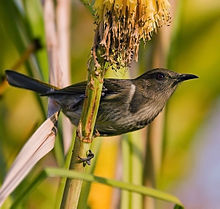Honeyeater
| Honeyeaters | |
|---|---|

| |
| Female crescent honeyeater (Phylidonyris pyrrhopterus) | |
| Scientific classification | |
| Domain: | Eukaryota |
| Kingdom: | Animalia |
| Phylum: | Chordata |
| Class: | Aves |
| Order: | Passeriformes |
| Superfamily: | Meliphagoidea |
| Family: | Meliphagidae Vigors, 1825 |
| Genera[1] | |
|
See text | |
The honeyeaters are a large and diverse
In total, there are
The extent of the evolutionary partnership between honeyeaters and
Description

Honeyeaters can be either nectarivorous, insectivorous, frugivorous, or a combination of nectar- and insect-eating.[7] Unlike the hummingbirds of America, honeyeaters do not have extensive adaptations for hovering flight, though smaller members of the family do hover hummingbird-style to collect nectar from time to time. In general, honeyeaters prefer to flit quickly from perch to perch in the outer foliage, stretching up or sideways or hanging upside down at need. Many genera have a highly developed brush-tipped tongue, frayed and fringed with bristles which soak up liquids readily. The tongue is flicked rapidly and repeatedly into a flower, the upper mandible then compressing any liquid out when the bill is closed.
In addition to nectar, all or nearly all honeyeaters take insects and other small creatures, usually by hawking, sometimes by gleaning. A few of the larger species, notably the white-eared honeyeater, and the strong-billed honeyeater of Tasmania, probe under bark for insects and other morsels. Many species supplement their diets with a little fruit, and a small number eat considerable amounts of fruit,[8] particularly in tropical rainforests and, oddly, in semi-arid scrubland. The painted honeyeater is a mistletoe specialist. Most, however, exist on a diet of nectar supplemented by varying quantities of insects. In general, the honeyeaters with long, fine bills are more nectarivorous, the shorter-billed species less so, but even specialised nectar eaters like the spinebills take extra insects to add protein to their diet when breeding.
The movements of honeyeaters are poorly understood. Most are at least partially mobile but many movements seem to be local, possibly between favourite haunts as the conditions change. Fluctuations in local abundance are common, but the small number of definitely migratory honeyeater species aside, the reasons are yet to be discovered. Many follow the flowering of favourite food plants. Arid zone species appear to travel further and less predictably than those of the more fertile areas. It seems probable that no single explanation will emerge: the general rule for honeyeater movements is that there is no general rule.
Taxonomy and systematics
The genera
The
In 2008, a study that included molecular phylogenetic analysis of museum specimens in the genera Moho and Chaetoptila, both extinct genera endemic to the Hawaiian islands, argued that these five species were not members of the Meliphagidae and instead belong to their own distinct family, the Mohoidae.[12]
References
- ISBN 0-300-04969-2.
- PMID 24315868.
- ISBN 978-84-96553-42-2
- Rasmussen, Pamela, eds. (2020). "Honeyeaters". IOC World Bird List Version 10.1. International Ornithologists' Union. Retrieved 22 February 2020.
- S2CID 250147316.
- PMID 15263073.
- PMID 15120392. Archived from the original(PDF) on 1 May 2012.
- ISBN 1-85391-186-0.
- doi:10.1071/zo07007.
- PMID 10714877.
- S2CID 85753152.
- PMID 19084408.
Further reading
- Ford, H.A. (2001). "Family Meliphagidae honeyeaters and Australian chats" (PDF). In Higgins, Peter J.; Peter, Jeffrey M.; Steele, W.K. (eds.). ISBN 0-19-553258-9.
External links
- Honeyeater videos on the Internet Bird Collection
- Meliphagoidea – Highlighting relationships of Maluridaeon Tree Of Life Web Project
